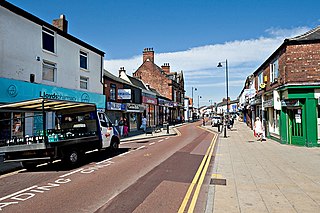
Atherton is a town in the Metropolitan Borough of Wigan, in Greater Manchester, England and historically a part of Lancashire. The town, including Hindsford, Howe Bridge and Hag Fold, is 5 miles (8.0 km) east of Wigan, 2 miles (3.2 km) north of Leigh, and 10+3⁄4 miles (17.3 km) northwest of Manchester. From the 17th century, for about 300 years, Atherton was known as Chowbent, which was frequently shortened to Bent, the town's old nickname.
The Manchester and Wigan Railway refers to a railway in North West England, opened in 1864 and closed to passengers on 3 May 1969, which was part of the London and North Western Railway before the Grouping of 1923. This route was an alternative to the surviving route through Swinton, Walkden and Atherton.

Astley was a railway station on the Liverpool and Manchester Railway on Chat Moss to the south of Astley village in what was then the county of Lancashire, England.
Tyldesley railway station is a closed railway station in Lancashire. It was situated within the historic county of Lancashire.
The Tyldesley Loopline was part of the London and North Western Railway's Manchester and Wigan Railway line from Eccles to the junction west of Tyldesley station and its continuance south west via Bedford Leigh to Kenyon Junction on the Liverpool and Manchester Railway. The line opened on 1 September 1864 with stations at Worsley, Ellenbrook, Tyldesley, Leigh and Pennington before joining the Liverpool and Manchester Railway at Kenyon Junction.
Leigh was a railway station in Bedford, Leigh, Greater Manchester, England, United Kingdom on the London and North Western Railway. Leigh was in the historic county of Lancashire. Its station opened as Bedford Leigh in 1864, was renamed Leigh & Bedford in 1876 and Leigh in 1914. The station closed in 1969.
Kenyon Junction was a railway station at Kenyon near Culcheth in Warrington, England. The station was built at the junction of the Liverpool and Manchester Railway and the Kenyon and Leigh Junction Railway. It was situated in the historic county of Lancashire. The station opened in 1830 as Bolton Junction and closed to passengers on 2 January 1961 before closing completely on 1 August 1963. The junction fell out of use when the line serving Leigh was closed in 1969.
Pennington railway station served Pennington, Leigh, Greater Manchester, England on the Bolton and Leigh Railway. It was situated within the historic county of Lancashire.
Westleigh or West Leigh was a station in Leigh, Greater Manchester, England on the Bolton and Leigh Railway line. Westleigh was situated within the historic county of Lancashire. Its station opened in 1831 and closed in 1954.
The Astley and Tyldesley Collieries Company formed in 1900 owned coal mines on the Lancashire Coalfield south of the railway in Astley and Tyldesley, then in the historic county of Lancashire, England. The company became part of Manchester Collieries in 1929 and some of its collieries were nationalised in 1947.
Tyldesley Coal Company was a coal mining company formed in 1870 in Tyldesley, on the Manchester Coalfield in the historic county of Lancashire, England that had its origins in Yew Tree Colliery, the location for a mining disaster that killed 25 men and boys in 1858.
Bedford Colliery, also known as Wood End Pit, was a coal mine on the Manchester Coalfield in Bedford, Leigh, Lancashire, England. The colliery was owned by John Speakman, who started sinking two shafts on land at Wood End Farm in the northeast part of Bedford, south of the London and North Western Railway's Tyldesley Loopline in about 1874. Speakman's father owned Priestners, Bankfield, and Broadoak collieries in Westleigh. Bedford Colliery remained in the possession of the Speakman family until it was amalgamated with Manchester Collieries in 1929.
Manchester Collieries was a coal mining company with headquarters in Walkden formed from a group of independent companies operating on the Manchester Coalfield in 1929. The Mining Industry Act of 1926 attempted to stem the post-war decline in coal mining and encourage independent companies to merge in order to modernise and better survive the economic conditions of the day. Robert Burrows of the Atherton company Fletcher Burrows proposed a merger of several independent companies operating to the west of Manchester. The merger was agreed and took place in March 1929.
Fletcher, Burrows and Company was a coal mining company that owned collieries and cotton mills in Atherton, Greater Manchester, England. Gibfield, Howe Bridge and Chanters collieries exploited the coal mines (seams) of the middle coal measures in the Manchester Coalfield. The Fletchers built company housing at Hindsford and a model village at Howe Bridge which included pithead baths and a social club for its workers. The company became part of Manchester Collieries in 1929. The collieries were nationalised in 1947 becoming part of the National Coal Board.
Chequerbent railway station was in Westhoughton to the south-west of Bolton, Greater Manchester, on a deviation of the original Bolton Great Moor St to Kenyon Junction line. The station replaced an earlier station on the original line of the railway that had been served by a stationary engine. It was open from 1885 until 1952 for passengers and 1965 for freight.
Haydock railway station served the village of Haydock, formerly in Lancashire, now in Merseyside, England.
Golborne South railway station was one of two stations serving the town of Golborne, to the south of Wigan.

Bamfurlong railway station served the village of Bamfurlong part of Abram, to the south of Wigan.

Platt Bridge railway station is a closed railway station in the Platt Bridge area of Wigan, England, where the line bridged Liverpool Road.
Hindley Green railway station is a closed railway station in the Hindley Green area of Wigan, England, where Leigh Road bridged the line.



